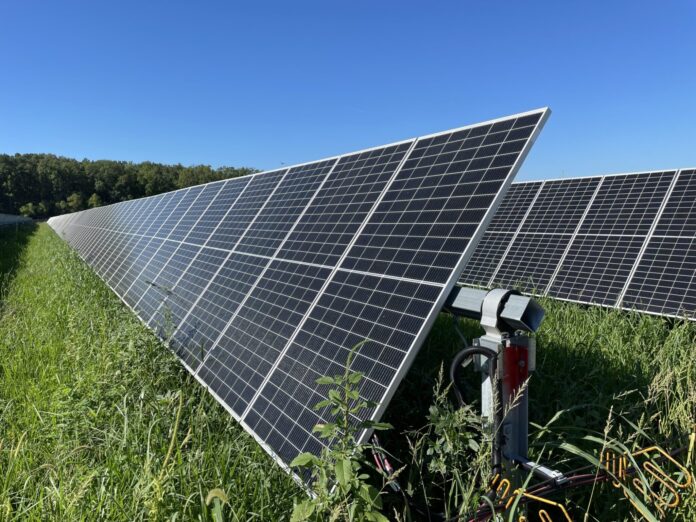New rules for building solar energy projects on prime Virginia farmland and forested areas are part of the ongoing solar siting discussion in the state and are drawing ire from solar developers but support from the farmers and the forestry industry.
The rules, known as House Bill 206 regulations, stem from legislation passed in the 2022 session that established the legal determination that solar projects generating up to 150 megawatts would have an adverse impact and require mitigation if they were built on more than 10 acres of prime farmland, and 50 acres of contiguous forested land.
Prime farmland is critical to the agricultural industry in Virginia because of its rich soils that help crop growth. Forests provide wildlife habitat, capture carbon from the air and soak up floodwaters.
But the Virginia Clean Economy Act, a 2020 law seeking to decarbonize the grid, mandates that Dominion Energy build about 16,100 megawatts of solar power and Appalachian Power Company build 600 megawatts.
With the general rule of thumb being that one megawatt of solar needs about seven acres, the potential development of solar has rural communities fuming over projects taking away their cherished landscapes and contributions to the agricultural and forestry industries.
“This bill was meant to try and strike that balance,” Del. Michael Webert, R-Fauquier, said during a panel discussion at the Virginia Clean Energy Summit.
Over the past five years, about 2,400, or 3%, of the 97,000 acres of prime farmland lost annually has been taken up by solar, with other types of development making up the difference in losses, according to the Department of Environmental Quality. About 7,730 acres of forest has been lost over that period.
The proposed rules are the culmination of two stakeholder groups’ discussions over the past two years. DEQ is reviewing the comments and is expected to finalize them early next year.
What the rules call for
The rules largely follow a 1:1 mitigation ratio for the two types of land, meaning that for every acre that is disturbed on-site, developers must take mitigation steps to conserve that amount on- site or off-site, including paying for easements that prevent development to protect the same type of land in nearby areas.
The amount of mitigation needed can change depending on certain steps taken during development. One example would be a developer not changing the grade or slope of the land, which can alter how much erosion occurs from water running off of the panels.
Mitigation requirements can also be reduced by limiting soil compaction in order to help the land return to agricultural production at the end of a solar facilities’ typical 30-year lifecycle. Incorporating agrivoltaics and preserving riparian forest buffers can also prevent erosion along waterways and soak up pollutants.
Disturbance of C1 or C2 forest corridors, which are recognized as having enhanced wildlife and environmental benefits, do require increased mitigation measures.
“It’s very clear as to what has to be mitigated, but it says nothing about how to mitigate those impacts, so we looked at the different tools,” said Jonathan Rak, chief policy advisor at DEQ.
Conflicting comments
Solar developers see the rules as being costly, while agricultural community members support the requirements to preserve land for Virginia’s top economy.
The regulations “overlook solar’s substantial economic contributions, including thousands of jobs, millions in tax revenues, land-lease payments, and significant capital investment in Virginia,” wrote Marshall Conrad, with the North Carolina-based solar developer Strata Clean Energy.
Environmental groups, including the Southern Environmental Law Center, the Chesapeake Climate Action Network, the Sierra Club and the Natural Resources Defense Council, submitted comments voicing similar concerns, saying the easement costs “could easily exceed $2 million at larger facilities,” and could push developers to a lengthier approval process at the State Corporation Commission.
But other environmental groups, like the Chesapeake Bay Foundation and Virginia Association of Soil and Water Conservation Districts, supported or wanted to strengthen the rules because of the potential harm solar development poses to Chesapeake Bay cleanup goals, which includes planting trees.
“Utility scale solar projects are therefore impairing Virginia’s ability to meet its environmental obligations to the Chesapeake Bay region,” Scott Cameron, second vice president of the Virginia Soil and Water Conservation District, wrote in comments sent to the board.
On the agricultural front, the Virginia Cattlemen’s Association pointed to the concern that about 500,000 acres of all types of Virginia farmland have been lost over the past five years as reason to support the rules to keep farmland in production. And the Virginia Forestry Products Association voiced similar worries over the loss of trees, but noted a potential unintended consequence of 500 acres of forestland being lost to solar development, and another 500 acres of land going under an easement.
“The potential net effect of this type of mitigation is instead of sawmills losing 500 acres for future harvest, we have lost 1,000 acres if truly commercial timber harvesting is in any way discouraged under these easements,” wrote the Virginia Forestry Products Association.
Disturbed lands
To avoid using farmland or forested areas, many have suggested developing solar projects on previously mined land that’s already been disturbed.
According to Virginia Energy, there are 125,000 acres of that land available, though some if it is remote with limited distribution lines, has rocky terrain that could be challenging to build on and could be used for economic development projects aimed at revitalizing the area.
“I think there’s a balance there of looking at what locations are better suited for some types of development,” said Daniel Kestner, economic development program manager at Virginia Energy.
NEWSLETTER SIGNUP
Subscribe to our newsletter! Get updates on all the latest news in Virginia.



